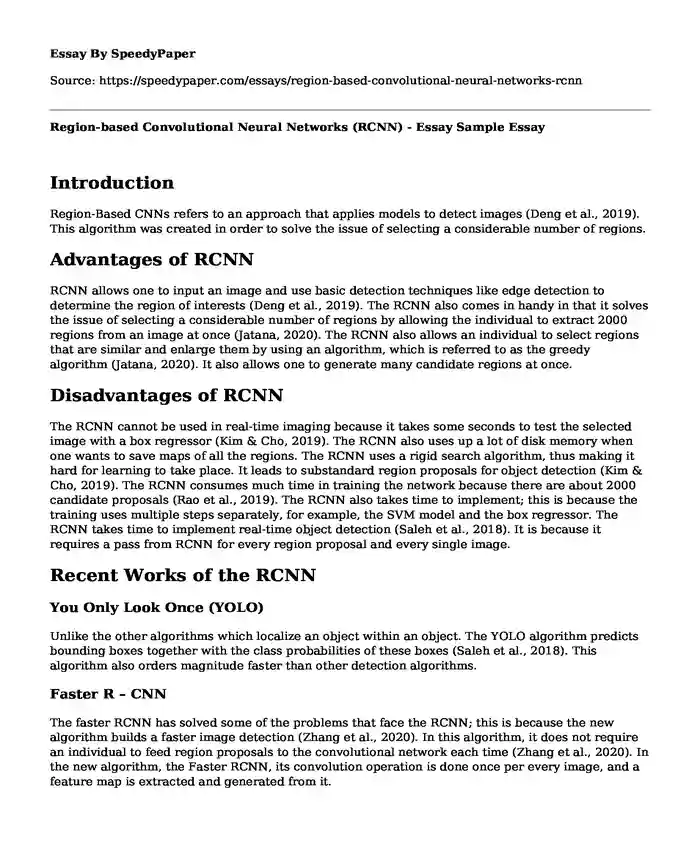
| Type of paper: | Essay |
| Categories: | Social networks Computer science Technology Electronics |
| Pages: | 3 |
| Wordcount: | 797 words |
Introduction
Region-Based CNNs refers to an approach that applies models to detect images (Deng et al., 2019). This algorithm was created in order to solve the issue of selecting a considerable number of regions.
Advantages of RCNN
RCNN allows one to input an image and use basic detection techniques like edge detection to determine the region of interests (Deng et al., 2019). The RCNN also comes in handy in that it solves the issue of selecting a considerable number of regions by allowing the individual to extract 2000 regions from an image at once (Jatana, 2020). The RCNN also allows an individual to select regions that are similar and enlarge them by using an algorithm, which is referred to as the greedy algorithm (Jatana, 2020). It also allows one to generate many candidate regions at once.
Disadvantages of RCNN
The RCNN cannot be used in real-time imaging because it takes some seconds to test the selected image with a box regressor (Kim & Cho, 2019). The RCNN also uses up a lot of disk memory when one wants to save maps of all the regions. The RCNN uses a rigid search algorithm, thus making it hard for learning to take place. It leads to substandard region proposals for object detection (Kim & Cho, 2019). The RCNN consumes much time in training the network because there are about 2000 candidate proposals (Rao et al., 2019). The RCNN also takes time to implement; this is because the training uses multiple steps separately, for example, the SVM model and the box regressor. The RCNN takes time to implement real-time object detection (Saleh et al., 2018). It is because it requires a pass from RCNN for every region proposal and every single image.
Recent Works of the RCNN
You Only Look Once (YOLO)
Unlike the other algorithms which localize an object within an object. The YOLO algorithm predicts bounding boxes together with the class probabilities of these boxes (Saleh et al., 2018). This algorithm also orders magnitude faster than other detection algorithms.
Faster R – CNN
The faster RCNN has solved some of the problems that face the RCNN; this is because the new algorithm builds a faster image detection (Zhang et al., 2020). In this algorithm, it does not require an individual to feed region proposals to the convolutional network each time (Zhang et al., 2020). In the new algorithm, the Faster RCNN, its convolution operation is done once per every image, and a feature map is extracted and generated from it.
Hand Gesture Recognition Based on Faster-RCNN Deep LearningThe recent works include the Hand Gesture Recognition which was developed to solve hand gesture recognition (Zhou & Gu, 2020). The new approach uses Faster RCNN and five layers of the neural network.
Applications
The RCNN is used to track objects from drones that are mounted with cameras. The RCNN is also used to locate texts which are found in an image. It also comes in handy since it enables detecting images in google lens (Zhou & Gu, 2020). The RCNN is used in tracking and detection of babies by outlaying the objects in the form of 2D images (Zhou & Gu, 2020). The RCNN is also used in autonomous driving, facial recognition software, and together with surveillance systems to detect any moving objects.
Limitations
It is time-consuming because it takes a significant amount of time to train the network since an individual is supposed to group 2000 regions per image. The RCNN cannot implement real-time; this is because it takes a maximum of 47 seconds to test each image (Zhang et al., 2020). The RCNN contains a selective search, which is a fixed algorithm; thus, no learning can take place in this particular stage.
References
Deng, J., Lu, Y., & Lee, V. (2019). Concrete crack detection with handwriting script interferences using faster regionbased convolutional neural network. Computer-Aided Civil And Infrastructure Engineering, 35(4), 373-388. https://doi.org/10.1111/mice.12497
Jatana, V. (2020). Classifying Metastatic Cancer Lymph Node Histopathology Using Cross Validation on Convolutional Neural Networks. SSRN Electronic Journal. https://doi.org/10.2139/ssrn.3631450
Kim, B., & Cho, S. (2019). Imagebased concrete crack assessment using mask and regionbased convolutional neural network. Structural Control and Health Monitoring, e2381. https://doi.org/10.1002/stc.2381
Rao, T., Li, X., Zhang, H., & Xu, M. (2019). Multi-level region-based Convolutional Neural Network for image emotion classification. Neurocomputing, 333, 429-439. https://doi.org/10.1016/j.neucom.2018.12.053
Saleh, K., Hossny, M., & Nahavandi, S. (2018). Effective Vehicle-Based Kangaroo Detection for Collision Warning Systems Using Region-Based Convolutional Networks. Sensors, 18(6), 1913. https://doi.org/10.3390/s18061913
Zhang, K., Cai, Y., Ren, Y., Ye, R., & He, L. (2020). MTF-CRNN: Multiscale Time-Frequency Convolutional Recurrent Neural Network for Sound Event Detection. IEEE Access, 8, 147337-147348. https://doi.org/10.1109/access.2020.3015047
Zhou, L., & Gu, X. (2020). Embedding topological features into convolutional neural network salient object detection. Neural Networks, 121, 308-318. https://doi.org/10.1016/j.neunet.2019.09.009
Cite this page
Region-based Convolutional Neural Networks (RCNN) - Essay Sample. (2023, Dec 28). Retrieved from https://speedypaper.net/essays/region-based-convolutional-neural-networks-rcnn
Request Removal
If you are the original author of this essay and no longer wish to have it published on the SpeedyPaper website, please click below to request its removal:
- Essay Sample on the Romance in the Digital Age
- Internet Privacy Developments - Essay Sample
- Free Essay: How Competition Influences Mobile Communication and Computing Infrastructure in Dominica
- Issues Implicated, and the Expected Outcome of the Request. Free Essay
- Technology Revolutionizing Healthcare: Electronic Health Records - Essay Sample
- Essay Example: Project Management Software be Used to Develop a Project WBS
- Edward Snowden is a Hero - Argumentative Essay
Popular categories




